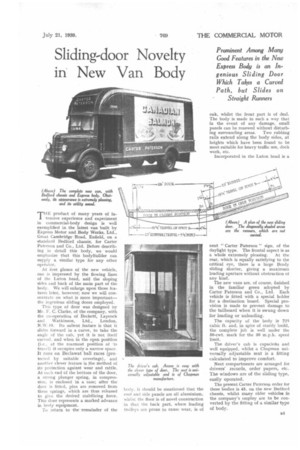Sliding-door Novelty in New Van Body
Page 35

If you've noticed an error in this article please click here to report it so we can fix it.
Prominent Among Many Good Features in the New Express Body is an Ingenious Sliding DOOF Which Takes a Curved Path, but Slides on
Straight Runners
T.HEproduct of many years of intensive experience and experiment in commercial-body design is well exemplified in the latest van built by Express Motor and Body Works, Ltd., Great Cambridge-Road, Enfield, on a standard Bedford chassis, for Carter Paterson and Co., Ltd. Before describing in detail this body, we would emphasize that this bodylkilder can supply a similar type for any other operator.
At first glance of the new vehicle, one is impressed by the flowing lines of the Luton head, and the sloping sides and back of the main part of the body. We will enlarge upon those featuies later, however; now we will concentrate on what is more important— the ingenious sliding doors employed.
This type of door was designed by Mr. F. C. Clarke, of the company, with the co-operation of Beckett, Laycock and Watkinson, Ltd., London, N.W. 10. its salient feature is that it slides forward in a curve, to take the angle of the cab, yet it is not itself curved, and when in the open position (i.e.. at the rearmost position of 'ts travel) it occupies only a narrow space. It runs on Beclawat ball races (protected by suitable coverings), and another clever feature is the method of its protection against wear and rattle. At each end of the bottom of the door, a strong plunger spring, in compression, is enclosed in a case: after the door is fitted, pins are removed from these springs, which are thus released to give the desired stabilizing force. This door represents a marked advance in body equipment.
To return to the remainder of the
body, it should be mentioned that the root and side panels are all aluminium, whilst the floor is of novel construction in that the back part, where loading trolleys are prone to cause wear, is of oak, whilst the front part is of deal. The body is made in such a way that in the event of any damage, small panels can be renewed without disturbing surrounding areas. Two rubbing rails extend along the body sides, at heights which have been found to be most suitable for heavy traffic use, dock work, etc.
Incorporated in the Luton head is a
neat "Carter Paterson" sign, of the daylight type. The frontal aspect is as a whole extremely pleasing. At the rear, which is equally satisfying to the critical eye, there is a large Brady sliding shutter, giving a maximum loading aperture without obstruction of any kind.
The new vans are, of course, finished in the familiar green adopted by Carter Paterson and Co., Ltd, Each vehicle is fitted with a special holder for a destination board. Special provision is made to prevent damage to the tailboard when it is swung down for loading or unloading.
The capacity of the body is 72i cubic ft. and, in spite of sturdy build, the complete job is well under the 50-cwt. mark for the 30 m.p.h. speed limit.
The driver's cab is capacious and well equipped, whilst a Chapman universally adjustable seat is a fitting calculated to improve comfort.
Neat compartments are arranged for drivers' records, order papers, etc. The windows are of the sliding type, easily operated.
The present Carter Paterson order for these bodies is 45, on the new Bedford chassis, whilst many older vehicles in the company's employ are to be converted by the fitting of a similar type of body.












































































